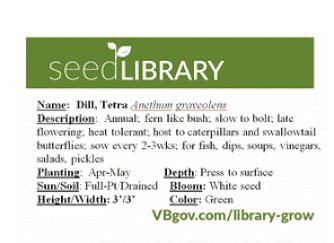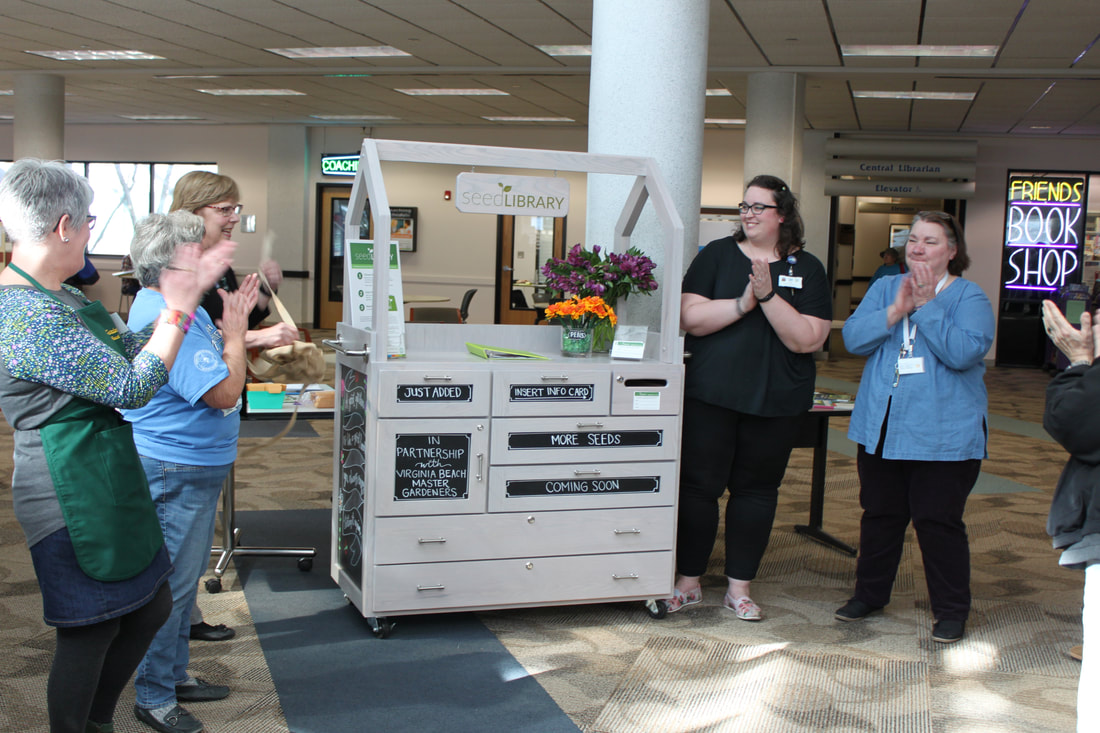Seed Library Cart
|
Thank you for your interest in the Virginia Beach Public Library and Virginia Beach Master Gardeners (VBMG) Seed Library Cart. The Seed Library is a free program offered to any Virginia Beach resident. We hope to grow new gardeners, introducing our community to the joy of harvesting their own food, using herbs in their cooking, learning about a variety of flowering plants, and helping preserve the biodiversity of our plant population.
VBMGA has been stocking a Seed Cart at the front of the Central Library since 2018. Each month we provide a new set of seeds (Vegetable, Herb and Flower) for participants of the program to pick up from the cart. In 2021 we also opened seed carts at Princess Anne and Kempsville Libraries. Each packet provided has information on planting your seeds. Below you will find further explanation of the categories on your seed packet and helpful planting tips. Happy Growing! Use the button above to find growing information for specific seeds offered through the Seed Cart.
|
Seed Packs Explained
 Sample Seed Packet
Sample Seed Packet
NAME
What’s in a name? Well a lot when it comes to plants. The common name can be associated with hundreds of different varieties/species with hundreds of different attributes. The Botanical name (in italics) defines the specific species you are growing. When doing a search for information, always use the Botanical name.
Grow native as much as possible. This helps wildlife thrive and cuts down on invasive species and diseases. You can often tell where the plant is native by its botanical name (Japonica/Japan, Chinesis/China).
The following are some of the most common plant Families:
Apiaceae - Celery Family
Asteraceae - Aster Family
Brassicaceae - Mustard Family
Fabaceae - Bean Family
Liliaceae - Lily Family
Malvaceae - Mallow Family
Rosaceae - Rose Family
Solanaceae - Tomato Family
DESCRIPTION
This gives you more details on a plant to help you decide if it is ideal for your needs and location. The description may tell you if the plant is good for pollinators, if it has fragrance, or mention other special characteristics.
Annual – plant only grows that year, does not survive the winter
Perennial – plant does not go dormant or dies back and returns every year
Biennial - plants that live two years, bearing flowers and fruit only in the second year
Bolt – The plant diverts resources away from producing the edible parts such as leaves or roots to producing new seeds, resulting in flavor and texture changes, withering, and in general, a poor quality harvest. This tends to happen at the end of the growing season or if the weather conditions are not ideal for the plant (too hot/cold, too wet/dry, stressed, etc.).
Deadhead - Some plants may need to have spent flowers removed to encourage re-blooming.
Heirloom - an old cultivar of a plant that is grown and maintained by gardeners and farmers. These were commonly grown during earlier periods in human history, but are not used in modern large-scale agriculture.
Cut and come again – a plant that you can harvest a portion and let continue to grow, most often leafy greens.
PLANTING TIME
The time of year to plant outdoors and how long they last outdoors. Many plants can be started indoors where it’s warm and protected. Don’t plant outdoors until it’s safe for them to survive the elements.
What’s in a name? Well a lot when it comes to plants. The common name can be associated with hundreds of different varieties/species with hundreds of different attributes. The Botanical name (in italics) defines the specific species you are growing. When doing a search for information, always use the Botanical name.
Grow native as much as possible. This helps wildlife thrive and cuts down on invasive species and diseases. You can often tell where the plant is native by its botanical name (Japonica/Japan, Chinesis/China).
The following are some of the most common plant Families:
Apiaceae - Celery Family
Asteraceae - Aster Family
Brassicaceae - Mustard Family
Fabaceae - Bean Family
Liliaceae - Lily Family
Malvaceae - Mallow Family
Rosaceae - Rose Family
Solanaceae - Tomato Family
DESCRIPTION
This gives you more details on a plant to help you decide if it is ideal for your needs and location. The description may tell you if the plant is good for pollinators, if it has fragrance, or mention other special characteristics.
Annual – plant only grows that year, does not survive the winter
Perennial – plant does not go dormant or dies back and returns every year
Biennial - plants that live two years, bearing flowers and fruit only in the second year
Bolt – The plant diverts resources away from producing the edible parts such as leaves or roots to producing new seeds, resulting in flavor and texture changes, withering, and in general, a poor quality harvest. This tends to happen at the end of the growing season or if the weather conditions are not ideal for the plant (too hot/cold, too wet/dry, stressed, etc.).
Deadhead - Some plants may need to have spent flowers removed to encourage re-blooming.
Heirloom - an old cultivar of a plant that is grown and maintained by gardeners and farmers. These were commonly grown during earlier periods in human history, but are not used in modern large-scale agriculture.
Cut and come again – a plant that you can harvest a portion and let continue to grow, most often leafy greens.
PLANTING TIME
The time of year to plant outdoors and how long they last outdoors. Many plants can be started indoors where it’s warm and protected. Don’t plant outdoors until it’s safe for them to survive the elements.
|
PLANTING DEPTH
This gives you specific information on how to start your seeds. Scatter - to let sit on the surface because the seed needs light to germinate. 1/4” or more - is how much soil to use to cover the seed. Press into surface – surrounds the seed with soil but the top stays exposed Direct – Plant outside, does not transplant well from indoors SUN/SOIL How much sun and soil moisture the plant needs to survive and bloom well. Full – 8+ hours of sun per day Part – 4-6 hours sun per day Shade – 4 or less hours sun per day Wet – water daily (a site close to hose) Moist – don’t let dry out completely Dry – does not like to be wet |
BLOOM
The time of year your plant will flower or days until the plant is mature. Some flowers bloom once a season, only a couple of times a season or all season long. Vegetables may tend to go to seed after maturity date.
HEIGHT/WIDTH
This is the mature size of the plant. When you are starting seeds, take into account the height of the plant (taller/climbing plants to the back of the landscape) and the width (measure the area the mature plant will take up in the landscape).
COLOR
Especially for flowers, you want to pick the right color for your landscape. There are many species where one pack contains a variety of colors.
The time of year your plant will flower or days until the plant is mature. Some flowers bloom once a season, only a couple of times a season or all season long. Vegetables may tend to go to seed after maturity date.
HEIGHT/WIDTH
This is the mature size of the plant. When you are starting seeds, take into account the height of the plant (taller/climbing plants to the back of the landscape) and the width (measure the area the mature plant will take up in the landscape).
COLOR
Especially for flowers, you want to pick the right color for your landscape. There are many species where one pack contains a variety of colors.
A special thank you to the following seed companies for their donations!
|
Back to the Roots
BBB Seed Store Burpee Seeds Eden Brothers Ernst Conservation Seeds Fedco Seeds Ferry Morse Home Gardening |
High Mowing Seeds
Mary's Heirloom Seeds Park Seed Rohrer Seeds True Leaf Market The Good Seed Company |


